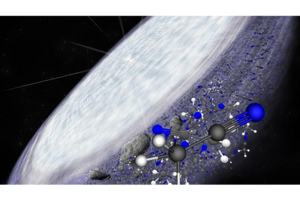Astronomers detect organic molecules in young star system
Scientists detected methyl cyanide and hydrogen cyanide molecules orbiting a young, distant star.

Artist's impression of complex organic molecules found in a protoplanetary disc.
B. Saxton (NRAO/AUI/NSF)
Sen—The discovery of life's building blocks in a young star shows that the conditions that create organic molecules can happen across the cosmos, scientists say.
Astronomers detected the presence of two molecules in the disc surrounding a star designated MWC 480, in a region that is considered similar to the Kuiper Belt around our own star.
In our Solar System, the Kuiper Belt is a collection of icy objects that includes comets, all of which reside beyond the orbit of Neptune.
"In the Solar System, complex organic molecules are common on many planets, moons, comets and asteroids. Comets are most relevant point of comparison for this study.
"They preserve a record of what the young Solar System looked like chemically and should have a similar chemical composition to the MWC 480 disk which is chemically comparable with our Solar System" Karin Öberg, lead author of the research, told Sen in an email.
"We now have even better evidence that this same chemistry exists elsewhere in the Universe, in regions that could form solar systems not unlike our own" said Öberg, Assistant Professor of Astronomy at the Harvard-Smithsonian Center for Astrophysics, in a statement.
MWC 480 is so young that the observatory that found the molecules has not been able to detect any planets or protoplanets yet. In the disc, scientists using the Atacama Large Millimeter/submillimeter Array (ALMA) found a carbon-based organic molecule called methyl cyanide, as well as a simpler version of it called hydrogen cyanide.
The star has formed out of an interstellar cloud of dust and gas, which astronomers know are ripe in organics. Cyanides are abundant in clouds and are considered interesting because they have bonds of carbon and nitrogen. These bonds form the basis of amino acids, proteins and life.
But the discovery of cyanides in MWC 480 was noteworthy because a young star's environment is much tougher than that of an interstellar cloud.
Because the radiation environment around a star is intense, and shocks are common, it was not clear if the chemical bonds could survive. However, ALMA found more of these molecules in this area than in interstellar clouds—showing that these discs are able to form the molecules quite quickly.
As telescopes become more sensitive, astronomers said they are hopeful they will one day detect organics in planets beyond our Solar System. However, Öberg explained to Sen: "It will be difficult to search for similarly complex molecules toward more evolved systems since the gas sublimating from debris in Kuiper belt analogs is unprotected from the stellar radiation field and thus quickly dissociates.
"Since this was a single molecule in a single system we will next try a more systematic survey to explore around which kind of stars, which kind of complex molecules are common."
The results from this study were published in Nature.
Related Links:
Mission to return an asteroid sample to Earth
Philae experiment grabbed precious data before lander lost power
Original story from Sen. © 2015 Sen TV Limited. All rights reserved. This material may not be published, broadcast, rewritten or redistributed. For more space news visit Sen.com and follow @sen on Twitter.

